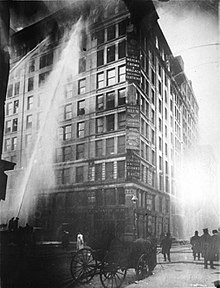Triangle Shirtwaist Factory fire
The fire at the Triangle Shirtwaist Factory on March 25, 1911 in New York , NY , also known as the Triangle Fire, was a fire that killed 146 people - mostly underage girls from immigrant families . A large proportion of the victims jumped from the upper floors onto the streets crowded with onlookers and died in front of the audience. The disaster has been investigated in detail and triggered an amendment to the introduction of fire and health and safety regulations in New York and the USA and against child labor .
Course of events
After the fire of the excursion ship General Slocum in 1904, this was the second major catastrophe that particularly affected immigrant families in New York within a few years.
As early as 1910, four smaller fires had broken out and put out in this factory. However, the owners described their factory as fire-safe, as the buildings met insufficient fire regulations in New York before the disaster.
The factory made garments that were sewn by around 500 young women under the age of 20. The rooms were crowded with machines and places and the exits were locked during working hours. On Saturday afternoon, March 25, at 4:45 p.m., another fire broke out on the 8th floor of the Asch Building in Greenwich Village , probably from a cigarette butt that had fallen onto a pile of scraps of cloth. Within a very short time the fire ate from one pile of cloth to the next and panic broke out. The girls could not open the locked doors and many died. The workers on the 10th floor were rescued from the roof by New York University students. They also managed to escape using the lifts designed for 15 people, which reached the locked floors, but which only fit 30 people at a time and which soon no longer worked. The fire only burned half an hour.
The trapped workers on the eighth floor tried to put out the fire, but this did not work because of the low water pressure in the pipes. The flames spread to the ninth floor and the locked building filled with smoke. A mountain of corpses formed on the inside of the locked main entrance. The only fire escape , a rusted old scaffolding, collapsed. Many of the girls on the ninth floor jumped out the window and hit the street after falling over 25 meters. Onlookers had gathered there. The New York fire department was there within a few minutes after the fire was reported, but despite modern equipment, they could not help the girls, as the longest ladder only reached up to the 6th floor.
146 bodies were found in the aftermath of the disaster, some of them sitting at their workplaces where they had sat again out of fear before choking on the gases.
consequences
In a subsequent court hearing, the owners, Max Blanck and Isaac Harris, were acquitted of the manslaughter charge because it could not be proven that they knew the doors were locked at the exact time of the fire. A few weeks later, they set up a new company in another building, where the doors were unlocked according to the new regulations, but closed by machines.
It was only in the years after the fire that fire protection and safety regulations were tightened and developed in the USA . The change was astonishingly implemented by the very anti-union boss of Tammany Hall , Charlie Francis Murphy, also known as "Silent Charlie" because of his public reluctance. As an Irishman, Murphy secured the votes of the Italians, whose girls mostly worked in the textile industry. There was a wave of factory visits that also included checks for child labor, poor sanitary conditions and unlit rooms.
The current building at this point is called the Brown Building and was granted National Historic Landmark status in July 1991 .
See also
- Fire trap - cinematic processing of the event
Web links
One day (Spiegel Online): The fire that changed America
Remarks
- ↑ Listing of National Historic Landmarks by State: New York. National Park Service , accessed August 19, 2019.

